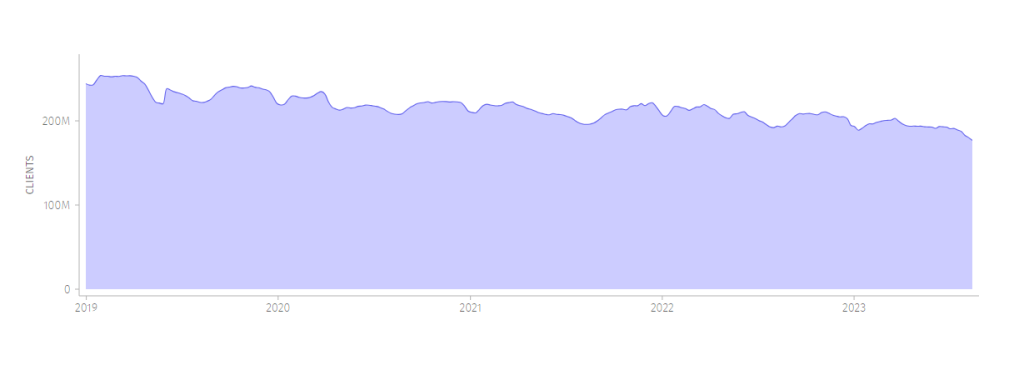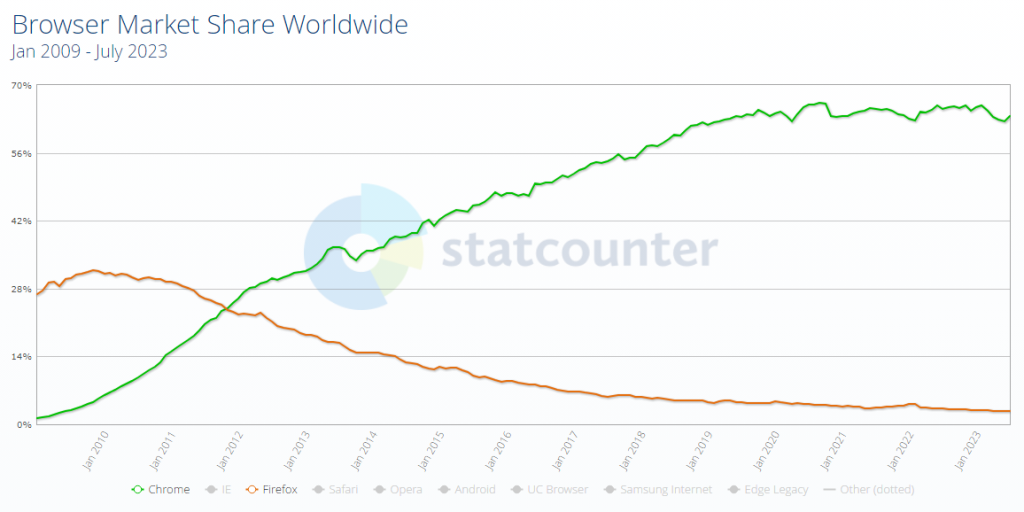Mozilla hosts a publicly accessible Firefox Public Data Report site that showcases the overall Worldwide usage of Firefox, including general usage data as well as other types of telemetry: hardware, languages, add-ons, etc.
If we go by the current usage snapshot between July 10th, 2022 to 2023, it appears that Mozilla is down roughly 3.92% (7.4 million) of users. Why July? Because that’s when the biggest dip happens across all countries that Mozilla shows in the report.
If we were to go by the current numbers as of today (August 22nd), it would be 9.5% (16.9M) of users lost, but that would be disingenuous based on the statement on Summer break usage below.

As per Mozilla itself,
Generally, MAU fluctuates over the course of a year, dropping in the summer months and during holidays. This effect can be observed quite clearly when comparing China and the United States. Both countries have noticeable dips starting in late Spring/early Summer and ending in September. However, the second holiday dip for the US occurs in December/January (corresponding with the Christmas/New Year’s holidays), while China’s holiday dip occurs in mid-to-late February (corresponding with Spring Festival).
Even if we give Mozilla generous margins on year by year basis, it doesn’t matter – the Firefox browser has been on a downward trend for the entirety of the report.
| Country | 2022 | 2023 | Difference |
|---|---|---|---|
| 🇧🇷 Brazil | 9.3M | 8.8M | -521K |
| 🇨🇳 China | 20.1M | 22.0M | 1.9M |
| 🇫🇷 France | 11.4M | 10.9M | -487K |
| 🇩🇪 Germany | 19.7M | 18.5M | -1.2M |
| 🇮🇳 India | 12.9M | 12.8M | -112K |
| 🇮🇩 Indonesia | 8.0M | 6.8M | -1.2M |
| 🇮🇹 Italy | 5.5M | 5.1M | -412K |
| 🇵🇱 Poland | 6.2M | 5.8M | -421K |
| 🇷🇺 Russia | 6.0M | 5.2M | -786K |
| 🇺🇸 United States | 21.8M | 20.7M | -1.1M |
| 🌍 Worldwide | 198.4M | 190.9M | -7.4M |
The decline in users from the United States has been fairly steady since January 2019:

Over the last couple of years, there haven’t been that many stories surrounding Firefox, probably the biggest story was the layoffs that were announced in 2020.
On August 11th, 2020, Mitchell Baker of Mozilla announced a comprehensive restructuring of the company, aiming to better position itself against Big Tech competitors. This restructuring, while striving to offer more innovative solutions, also came with the downside of laying off 250 employees.
On September 23rd, 2020, Cal Peterson wrote that amidst dwindling Firefox usage, Mozilla’s top executives saw their compensation soar by a staggering 400%. This discrepancy emerged against the backdrop of the company’s decision to lay off a quarter of its workforce, compromising key projects, including the MDN docs, Rust compiler, and portions of Firefox development.
While Mozilla cited the pandemic as a reason for the fall in its primary revenue from “royalties”, a deeper dive suggested the diminished user base and consequently reduced search royalties were to blame. Moreover, despite branding itself as a privacy-first browser, its primary revenue source is directing traffic to Google.
Is everyone going back to Chrome? Probably not.
There are a lot of browsers out there these days. As I recapped in my secure web browsers article, this is the current market share at a glance,
| Browser | Market Share |
|---|---|
| Chrome | 65.4% |
| Edge | 4.46% |
| Safari | 18.7% |
| Opera | 2.4% |
| Brave | 2.08% |
| Firefox | 3% |
| Tor | 0.24% |
| Total | 96.68% |
After Google published the Web Environment Integrity proposal, I also updated my Non-Chromium browsers article, which features projects like LibreWolf, Waterfox, Mullvad Browser, and others. The BraveBat website tracks Brave’s usage statistics, and since 2021 the browser has gone from 25M to 57M monthly active users.
Brave itself is based on Chromium (hence the popularity). However, they say they are forking it, and it’s not just a reskin of Chrome. The concern was raised in response to the WEI proposal mentioned above.
Is Mozilla’s focus too spread out?
From the 26 CSS properties introduced this year, Firefox supports very few of them (2 supported and 7 under flags). This may or may not be a major concern for developers who rely on browsers to support the latest standards so that they can provide the best experience to users. If Firefox consistently lags behind, developers may lose trust in the platform, which could, in turn, affect their willingness to optimize for it.
Historically, browsers that don’t stay updated with the latest web standards tend to lose market share. This happened with Internet Explorer in the 2000s when Firefox and later Chrome began to offer better compatibility and performance. If Firefox doesn’t keep up, it might face similar challenges. And in many ways, this is now happening with privacy also (case in point, Brave).
Mozilla is currently working on a Browser (mobile, desktop, and virtual reality), Relay (disposable emails), Monitor (data breach monitoring), Rust, Bugzilla, VPN, MDN, and numerous other projects.
And yet… the number of people using Firefox continues to dwindle.

In the grand scheme of things, if you have 200M users one year and 192M the next, you may attribute the loss of users to things like preference change and a natural occurrence. But the graphs clearly show a steady decline that has been rolling over year over year.













